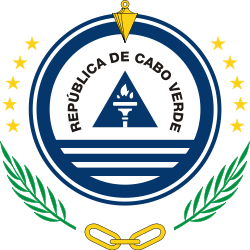Timeline of Brava, Cape Verde
Part of a series on the |
|---|
| History of Cape Verde |
 |
| Colonial history |
| Independence struggle |
|
|
The following is a timeline of the island of Brava, Cape Verde.
Prehistoric era
- About 20 million years ago: The seamount formed
- Around 3 to 2 million years ago: The island now known as Brava formed
- Around 5,000 years ago, as the sea level rose, Monte Fontainhas' elevation would mark under 1,000 meters.
Colonial era
See also: Timeline of Portuguese Cape Verde
- 1462 - The island was discovered by the Portuguese explorer Diogo Afonso
- 1573 - The island's first settlement established, the first settlers were from the Portuguese islands of Madeira and the Azores, slavery was absent in the first few decades
- 1579 - Sir Francis Drake visited the island
- 1580 - Approximate population: 100
- 17th and 18th centuries: Brava's coast raided by pirate attacks
- 1650 - Approximate population: 400
- 1680 - A influx of immigrants from the island of Fogo poured after the volcano erupted and lava began to flow and devastate the island
- 1720 - Approximate population: 1 200
- 1800 - Approximate population: 3 000
- 1826 - Nossa Senhora do Monte village founded[1]
- 1832 - Estimate population: 8,000[2]
- 1843
- 1862 - Nossa Senhora do Monte became a place of pilgrimage[4]
- 1867 - October 18: Eugénio Tavares was born, he would become the greatest Cape Verdean poet
- 1780s - First wave of emigration began as American whaling ships headed to the area within the island, some people emigrated, whaling was an important source of income on the island
- 1880 - Nova Sintra's Catholic church opened
- 1890 - Population: 9 784, the highest population reached
- 1900 - Population: 9 200
- 1922 - Estado Novo regime established, emigration to other countries including the United States would not be permitted for around 60 years
- 1930 - Population: 6 383
- 1930s - Economic crisis started mainly after the Great Depression and famines struck the island
- 1930s - The first Protestant church opened on the island, the Seventh Day Adventist church opened by missionaries from the United States[5]
- 1940 - Population: 8 528[6]
- 1943 - August 21: The ship Matilde sunk, nearly every family in Fajã de Água lost one or more relatives.
- 1950 - Population: 7 937[6]
- 1950s - Brava devastated by famine, some of the people emigrated nearly southeast to São Tomé and Príncipe, at the time, another Portuguese colony
- 1960 - Population: 8 625[6]
- 1970 - Population: 7 756[6]
- 1974 - April: the Carnation Revolution took place in Portugal, the Estado Novo regime collapsed, Cape Verde became an autonomous province
After independence in 1975-1999
- 1975
- March 12: Nô Pintcha football (soccer) club established
- July 5: Cape Verde declared independence from Portugal and became and independent nation
- 1980
- Population: 6 985[6]
- SC Morabeza football (soccer) club established
- Since 1980, a small wave of emigration much of it to Western Europe continued for the next few decades up to 2010
- 1982
- tropical storm Beryl hitted Brava, the port was flooded 10 meteres causing damages to boats[7]
- Seismic activity occurred on the island, this happened at Cadamosto seamount, 20 km southwest, the first of four happened in 22 years
- 1984 - Brava Island League founded
- 1988 - Sporting Clube da Brava football (soccer) club established
- 1990 - Population: 6 975[6]
- 1990 - Second seismic activity from the Cadamosto seamount happened on the island
- 1992 - Esperadinha Airport first opened, the latest air transportation hub opened in Cape Verde
- 1993 - Brava Island League resumed
- 1998 - Third seismic activity from the Cadamosto seamount happened on the island
21st century
- 2000
- Population: 6 804[8]
- The port of Furna was improved
- 2004
- GD Corôa football (soccer) club established
- Esperadinha Airport shut due to high winds
- Fourth and final seismic activity from the Cadamosto seamount happened on the island, it measured 4.3 on the Richter scale
- 2010
- Population: 5 971[9]
- March 13: Juventude da Furna football (soccer) club established
- Brava Island Cup and Super Cup held their first editions
- 2011 - 10 January: The new ferry boat,the Kriola connected the ports of São Filipe in Fogo and Praia in Santiago,[10] it is slightly faster than the previous ferry boat once used for fishing and only served Fogo
See also
- Timeline of Boa Vista, Cape Verde
- Timeline of Fogo, Cape Verde
- Timeline of Maio, Cape Verde
- Timeline of Sal, Cape Verde
- Timeline of Santiago, Cape Verde
- Timeline of Santo Antão, Cape Verde
- Timeline of São Nicolau, Cape Verde
- Timeline of São Vicente, Cape Verde
References
- ↑ Reitmaier, Pitt: Cabo Verde, p.415. Bielefeld 2009.
- ↑ Roberts, Edmund (1837). Embassy to the Eastern Courts of Cochin-China, Siam, and Muscat. New York: Harper & Brothers. p. 17.
- ↑ Reitmeier, Pitt: Cabo Verde, p.415. Bielefeld 2009.
- ↑ Reitmaier, Pitt: Cabo Verde, p.418. Bielefeld 2009.
- ↑ Land, Gary (2005). Historical Dictionary of Seventh-Day Adventists (= Historical Dictionaries of Religions, Philosophies, and Movements. Lanham MD: Scarecrow. p. 55. ISBN 0-8108-5345-0.
- 1 2 3 4 5 6 Source: Statoids
- ↑ Osang, Rolf: Kapverdische Inseln, p.151. Cologne 2001.
- ↑ Source: Instituto Nacional de Estatísticas.
- ↑ Portal do Instituto Nacional de Estatística: INE - CENSO 2010.
- ↑ "Brava recebe Kriola com entusiasmo (com fotos actualizadas)". A Semana (in Portuguese). 10 January 2011.
This article is issued from Wikipedia - version of the 11/9/2016. The text is available under the Creative Commons Attribution/Share Alike but additional terms may apply for the media files.